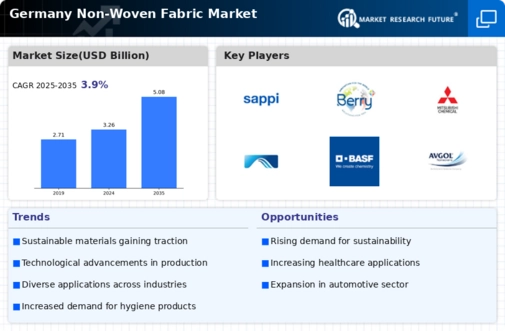The Germany Non-Woven Fabric Market is characterized by significant competitive dynamics influenced by several key players, innovation in manufacturing processes, and evolving consumer preferences. Non-woven fabrics are increasingly being adopted across various industries, including hygiene, automotive, medical, and construction, driven by their lightweight, durable, and versatile nature. The competition in this market is marked by the presence of established companies that leverage advanced technologies to produce high-quality, non-woven products while also focusing on sustainability and environmental concerns. Companies are investing in RD to enhance product performance and expand their applications, thereby strengthening their market positions.
As the demand for non-woven fabrics continues to grow in Germany, companies are striving to differentiate themselves through product quality, customer service, and efficient supply chain management.Sappi, a well-regarded player in the Germany Non-Woven Fabric Market, boasts a strong presence with its commitment to sustainable practices and innovative technology. The company has established itself as a leader in producing high-performance, non-woven fabrics that meet the unique needs of various applications, particularly in the hygiene and medical sectors.
Sappi’s strengths lie in its ability to efficiently manage production processes while ensuring that its materials are eco-friendly, aligning with the growing demand for sustainable products in Germany. By investing in advanced manufacturing techniques and building strong relationships with clients, Sappi effectively capitalizes on market opportunities and showcases its dedication to quality and sustainability.Berry Global, another prominent company in the Germany Non-Woven Fabric Market, offers a diverse range of products and services tailored to meet specific customer needs. The company has a significant market presence through its extensive portfolio of non-woven materials used in hygienic applications, medical products, and geotextiles.
Berry Global's strengths include its capability to produce innovative and customizable solutions, combined with its commitment to sustainable practices. The company has been actively pursuing mergers and acquisitions to enhance its market reach and product offerings in Germany. This strategic approach has enabled Berry Global to strengthen its competitive position and expand its operations, allowing it to effectively serve a growing customer base by providing high-quality and reliable non-woven fabric solutions.




















